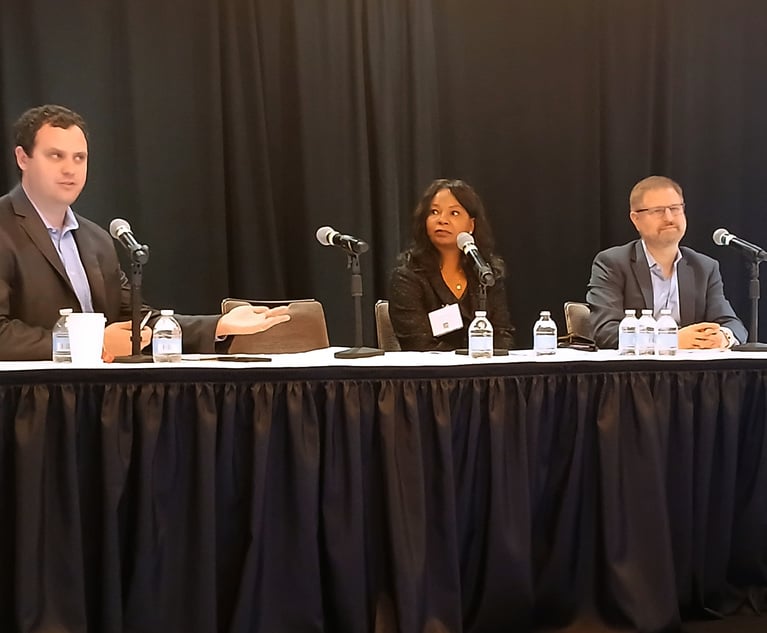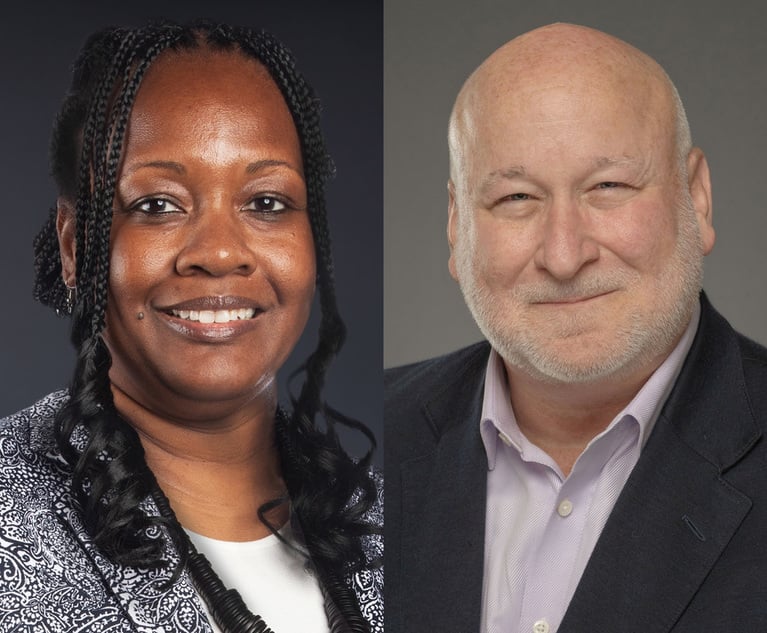Lehman Teaches Valuable Lesson to In-House Counsel
There's much to learn from Lehman Brothers' bankruptcy.
April 30, 2010 at 08:00 PM
6 minute read
As the U.S. financial markets melted down in 2008, I wondered how the in-house legal teams at the Wall Street firms were able to manage the immense internal and external pressures bearing down upon them. My curiosity involved abstract appreciation of the chaotic conditions under which the in-house teams operated. The examiner in the Lehman Brothers' bankruptcy, however, recently issued a detailed account of the storm that heralded Lehman's demise (See “Blaming Lehman”). The report, including its copious citation of e-mails reflecting management's frantic response to the crisis, permits in-house counsel to reflect upon how we would have handled our jobs amid that tempest.
In January 2008, Lehman's market capitalization was pegged at more than $30 billion; less than eight months later, Lehman sought bankruptcy protection. Although the bankruptcy examiner cited several reasons for Lehman's collapse, he concluded that its troubles were “exacerbated by Lehman's executives, whose conduct ranged from serious but nonculpable errors of business management to actionable balance sheet manipulation.” The examiner concluded that “colorable claims” exist against several officers who were allegedly responsible for the balance sheet management and who signed and certified Lehman's financial statements.
The examiner's report does not specifically take issue with the Lehman legal department's response to the crisis or its efforts to stave off Lehman's demise. Still, in-house counsel should use this detailed case study to assess our readiness to manage our ethical obligations amid corporate crisis. The examiner's meticulous report permits us to feel the perfect storm beating down upon Lehman. As the report specifies, Lehman deployed several survival strategies including enhanced use of an accounting “gimmick” that was designed solely to shore up Lehman's balance sheet. Lehman did not disclose the use of the questionable–but not illegal–accounting practices in its periodic reports and, according to the examiner, the lack of transparency misled the public and was actionable.
How might we conduct ourselves from the eye of that storm? No doubt, challenging business environments breed risky business practices. In Lehman's case, the business was in a death spiral. Could you oppose life support when your client is dying? Do ethics and codes of conduct even play a role in that environment?
Our code of conduct makes no exception for really difficult situations. In fact, Model Rules of Professional Conduct 1.6 (confidentiality of information) and 1.13(b – c) (up-the-ladder reporting) only address serious misconduct, not simply unwise business decisions. Indeed, a comment to Rule 1.13 clarifies that a lawyer's business judgment should not replace that of the constituents:
“When constituents of the organization make decisions for it, the decision ordinarily must be accepted by the lawyer even if their utility or prudence is doubtful. Decisions concerning policy and operations, including ones entailing serious risk, are not as such in the lawyer's province.”
Still, if the conduct–whether it is part of a survival strategy or not–involves serious misconduct that will likely result in substantial injury to the client, then we are expected to respond in some way, regardless of the pressures to participate or look away. We are expected to be pillars of ethical behavior even if those around us are blinded or distracted by the exigencies.
Do you have the courage to stand against indescribable pressure by your business partners to acquiesce to or participate in inappropriate business practices? Read the Lehman bankruptcy examiner's report and place yourselves in the eye of the storm that besieged Lehman. Gut check time.
As the U.S. financial markets melted down in 2008, I wondered how the in-house legal teams at the Wall Street firms were able to manage the immense internal and external pressures bearing down upon them. My curiosity involved abstract appreciation of the chaotic conditions under which the in-house teams operated. The examiner in the Lehman Brothers' bankruptcy, however, recently issued a detailed account of the storm that heralded Lehman's demise (See “Blaming Lehman”). The report, including its copious citation of e-mails reflecting management's frantic response to the crisis, permits in-house counsel to reflect upon how we would have handled our jobs amid that tempest.
In January 2008, Lehman's market capitalization was pegged at more than $30 billion; less than eight months later, Lehman sought bankruptcy protection. Although the bankruptcy examiner cited several reasons for Lehman's collapse, he concluded that its troubles were “exacerbated by Lehman's executives, whose conduct ranged from serious but nonculpable errors of business management to actionable balance sheet manipulation.” The examiner concluded that “colorable claims” exist against several officers who were allegedly responsible for the balance sheet management and who signed and certified Lehman's financial statements.
The examiner's report does not specifically take issue with the Lehman legal department's response to the crisis or its efforts to stave off Lehman's demise. Still, in-house counsel should use this detailed case study to assess our readiness to manage our ethical obligations amid corporate crisis. The examiner's meticulous report permits us to feel the perfect storm beating down upon Lehman. As the report specifies, Lehman deployed several survival strategies including enhanced use of an accounting “gimmick” that was designed solely to shore up Lehman's balance sheet. Lehman did not disclose the use of the questionable–but not illegal–accounting practices in its periodic reports and, according to the examiner, the lack of transparency misled the public and was actionable.
How might we conduct ourselves from the eye of that storm? No doubt, challenging business environments breed risky business practices. In Lehman's case, the business was in a death spiral. Could you oppose life support when your client is dying? Do ethics and codes of conduct even play a role in that environment?
Our code of conduct makes no exception for really difficult situations. In fact, Model Rules of Professional Conduct 1.6 (confidentiality of information) and 1.13(b – c) (up-the-ladder reporting) only address serious misconduct, not simply unwise business decisions. Indeed, a comment to Rule 1.13 clarifies that a lawyer's business judgment should not replace that of the constituents:
“When constituents of the organization make decisions for it, the decision ordinarily must be accepted by the lawyer even if their utility or prudence is doubtful. Decisions concerning policy and operations, including ones entailing serious risk, are not as such in the lawyer's province.”
Still, if the conduct–whether it is part of a survival strategy or not–involves serious misconduct that will likely result in substantial injury to the client, then we are expected to respond in some way, regardless of the pressures to participate or look away. We are expected to be pillars of ethical behavior even if those around us are blinded or distracted by the exigencies.
Do you have the courage to stand against indescribable pressure by your business partners to acquiesce to or participate in inappropriate business practices? Read the Lehman bankruptcy examiner's report and place yourselves in the eye of the storm that besieged Lehman. Gut check time.
This content has been archived. It is available through our partners, LexisNexis® and Bloomberg Law.
To view this content, please continue to their sites.
Not a Lexis Subscriber?
Subscribe Now
Not a Bloomberg Law Subscriber?
Subscribe Now
NOT FOR REPRINT
© 2025 ALM Global, LLC, All Rights Reserved. Request academic re-use from www.copyright.com. All other uses, submit a request to [email protected]. For more information visit Asset & Logo Licensing.
You Might Like
View All
Lawyers Drowning in Cases Are Embracing AI Fastest—and Say It's Yielding Better Outcomes for Clients

GC Conference Takeaways: Picking AI Vendors 'a Bit of a Crap Shoot,' Beware of Internal Investigation 'Scope Creep'
8 minute read
Why ACLU's New Legal Director Says It's a 'Good Time to Take the Reins'
Trending Stories
- 1Data Breach Lawsuit Against Byte Federal Among 1,500 Targeting Companies in 2024
- 2Counterfeiters Ride Surge in Tabletop Games’ Popularity, Challenging IP Owners to Keep Up
- 3Health Care Data Breach Class Actions Saw December Surge in NY Courts
- 4Florida Supreme Court Disbars 3, Suspends 11, Reprimands 1 in Final Disciplinary Order of 2024
- 5Chief Justice Roberts Ends Year With Defense Against 'Illegitimate' Attacks on Judiciary
Who Got The Work
Michael G. Bongiorno, Andrew Scott Dulberg and Elizabeth E. Driscoll from Wilmer Cutler Pickering Hale and Dorr have stepped in to represent Symbotic Inc., an A.I.-enabled technology platform that focuses on increasing supply chain efficiency, and other defendants in a pending shareholder derivative lawsuit. The case, filed Oct. 2 in Massachusetts District Court by the Brown Law Firm on behalf of Stephen Austen, accuses certain officers and directors of misleading investors in regard to Symbotic's potential for margin growth by failing to disclose that the company was not equipped to timely deploy its systems or manage expenses through project delays. The case, assigned to U.S. District Judge Nathaniel M. Gorton, is 1:24-cv-12522, Austen v. Cohen et al.
Who Got The Work
Edmund Polubinski and Marie Killmond of Davis Polk & Wardwell have entered appearances for data platform software development company MongoDB and other defendants in a pending shareholder derivative lawsuit. The action, filed Oct. 7 in New York Southern District Court by the Brown Law Firm, accuses the company's directors and/or officers of falsely expressing confidence in the company’s restructuring of its sales incentive plan and downplaying the severity of decreases in its upfront commitments. The case is 1:24-cv-07594, Roy v. Ittycheria et al.
Who Got The Work
Amy O. Bruchs and Kurt F. Ellison of Michael Best & Friedrich have entered appearances for Epic Systems Corp. in a pending employment discrimination lawsuit. The suit was filed Sept. 7 in Wisconsin Western District Court by Levine Eisberner LLC and Siri & Glimstad on behalf of a project manager who claims that he was wrongfully terminated after applying for a religious exemption to the defendant's COVID-19 vaccine mandate. The case, assigned to U.S. Magistrate Judge Anita Marie Boor, is 3:24-cv-00630, Secker, Nathan v. Epic Systems Corporation.
Who Got The Work
David X. Sullivan, Thomas J. Finn and Gregory A. Hall from McCarter & English have entered appearances for Sunrun Installation Services in a pending civil rights lawsuit. The complaint was filed Sept. 4 in Connecticut District Court by attorney Robert M. Berke on behalf of former employee George Edward Steins, who was arrested and charged with employing an unregistered home improvement salesperson. The complaint alleges that had Sunrun informed the Connecticut Department of Consumer Protection that the plaintiff's employment had ended in 2017 and that he no longer held Sunrun's home improvement contractor license, he would not have been hit with charges, which were dismissed in May 2024. The case, assigned to U.S. District Judge Jeffrey A. Meyer, is 3:24-cv-01423, Steins v. Sunrun, Inc. et al.
Who Got The Work
Greenberg Traurig shareholder Joshua L. Raskin has entered an appearance for boohoo.com UK Ltd. in a pending patent infringement lawsuit. The suit, filed Sept. 3 in Texas Eastern District Court by Rozier Hardt McDonough on behalf of Alto Dynamics, asserts five patents related to an online shopping platform. The case, assigned to U.S. District Judge Rodney Gilstrap, is 2:24-cv-00719, Alto Dynamics, LLC v. boohoo.com UK Limited.
Featured Firms
Law Offices of Gary Martin Hays & Associates, P.C.
(470) 294-1674
Law Offices of Mark E. Salomone
(857) 444-6468
Smith & Hassler
(713) 739-1250







